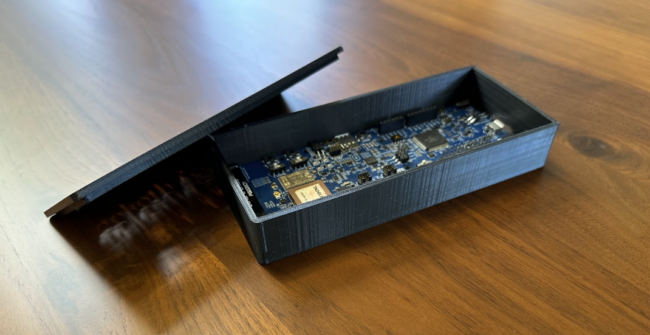This demo is targeted at tracking the location of small, high value items, without the need to add a cellular modem and GPS to each item. We combined the capabilities of local BLE beacons on microcontrollers running Zephyr and cloud connectivity through Golioth.
The problem
Say you run a construction site and want to prevent theft and keep track of all the equipment. Large equipment such as bulldozers and trucks have the power and the sticker price to support a separate cellular tracker. But small pieces like drills and hammers probably do not, they need to be powered by small batteries and run for a long time. One way to achieve this could be to attach a giant red flag to each piece of equipment and watch the site 24/7, but that wouldn’t be very practical (nor is it very fancy). A better solution would be to have each piece of equipment announce its presence to the surrounding area via some electronic device, and have another device listen for that announcement and send that data to the cloud.
How it works
Overview
At a high level, this concept is a simple Bluetooth beacon communicating to a central gateway that can interpret Bluetooth signals and translate them into useful data in the cloud, where it can be further processed. The advantage of this architecture is that it gets the data into the cloud as fast as possible, allowing for more complex computation off-chip! In this case, the Bluetooth signals come from a peripheral nRF52840 and are picked up by the central nRF9160-DK, both of which are explored in more detail later on in this post.
![]()
The tracker
A peripheral tracker, pictured below, is attached to each piece of construction equipment (or anything else that needs to be tracked). This tracker emits a simple Bluetooth Low Energy signal which announces its identity; “I am AA:BB:CC:DD:EE:FF,” for example. This is later tied to the identity of the device such as “Drill number 1”. This signal is then received by another device central to the location of interest, coined the gateway.
![]()
The gateway
The gateway, the nRF9160-DK in this case, is responsible for receiving the announcements from the peripheral trackers and interpreting their data, as well as sending that data to the cloud. When the gateway picks up an announcement it internally logs the announcing device’s name and received signal strength (RSSI), which it may then send to the Golioth Console to be graphed over time.

Golioth Features
Remote procedure calls
We structured this demo to have the gateway be “in charge” of verified devices on the tracking list. For this type of application to work, there must be a list of devices somewhere on the gateway that it should keep track of, otherwise it would report on every Bluetooth device in the area, which could be hundreds of signals! Hardcoding this list is one option, but does not grant the flexibility of adding and removing devices from the list. Creating and editing this list remotely is much more user friendly, and Golioth makes this very easy to do with Remote Procedure Calls (RPCs). This demo set up RPCs to add, remove, view, and clear all devices from the gateway’s list. The code block below shows the declarations of those RPC functions. The image then shows their use in the Golioth console.
static enum golioth_rpc_status add_device(zcbor_state_t *request_params_array, zcbor_state_t *response_detail_map, void *user_data); static enum golioth_rpc_status remove_device(zcbor_state_t *request_params_array, zcbor_state_t *response_detail_map, void *user_data); static enum golioth_rpc_status list_devices(zcbor_state_t *request_params_array, zcbor_state_t *response_detail_map, void *user_data); static enum golioth_rpc_status clear_devices(zcbor_state_t *request_params_array, zcbor_state_t *response_detail_map, void *user_data);
When a new asset is added to a fleet (“Drill number 2”), an app calls the Golioth REST API to trigger the “Add device” RPC, which then pushes the new UID to the Gateway. Now the Gateway may begin passing messages from local devices through to the cloud.
Data Streaming
It’s extremely simple to send data to the cloud via the Stream API. Data from the gateway can easily be sent to the Stream in JSON format where it can be viewed on the console or extracted for visualization using another tool, like Grafana. Newer tools like Pipelines make it so that the data can be routed out to any 3rd party application or service.
![]()
After a device has been added to the allowlist via RPC, the Gateway would begin passing messages from that gateway through to the cloud, which the app could view on LightDB Stream (via the REST API) or via a 3rd party database service via Golioth Pipelines.
Other Applications
This demonstration offers a simple example of what can be done using BLE gateways and Golioth to track important assets across a localized area. Construction equipment on site is one example application, but others may include:
- Supplies on a school campus
- Equipment in an office building
- Merchandise in a warehouse
- Valuables in a storefront
- And more!
Any situation where you may have valuables or a large quantity of assets concentrated into one environment, a cloud connected BLE tracking solution may be a great way to keep those assets accounted for.


No comments yet! Start the discussion at forum.golioth.io